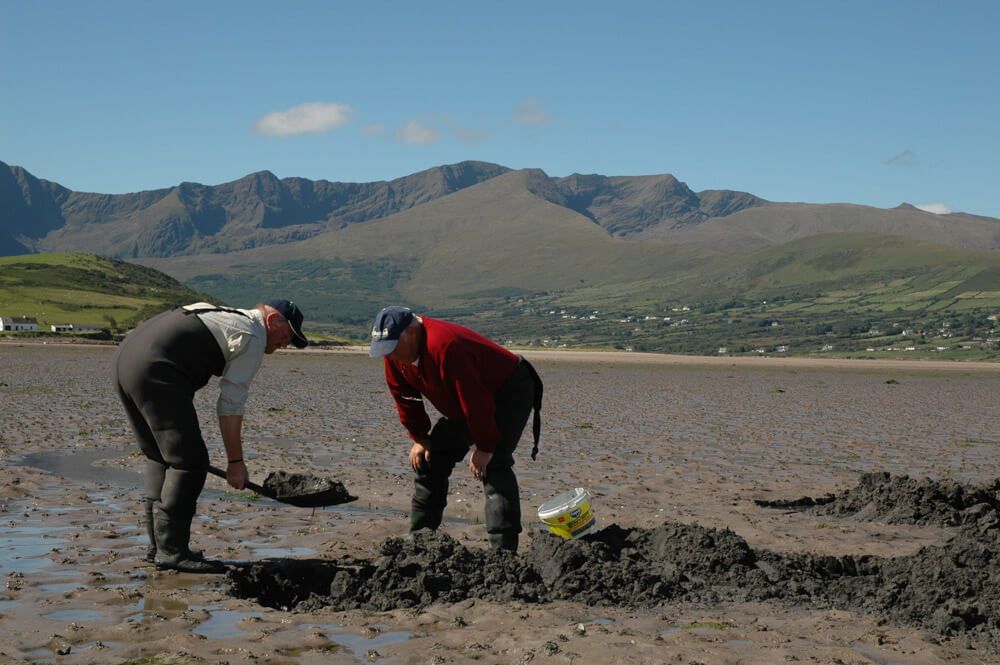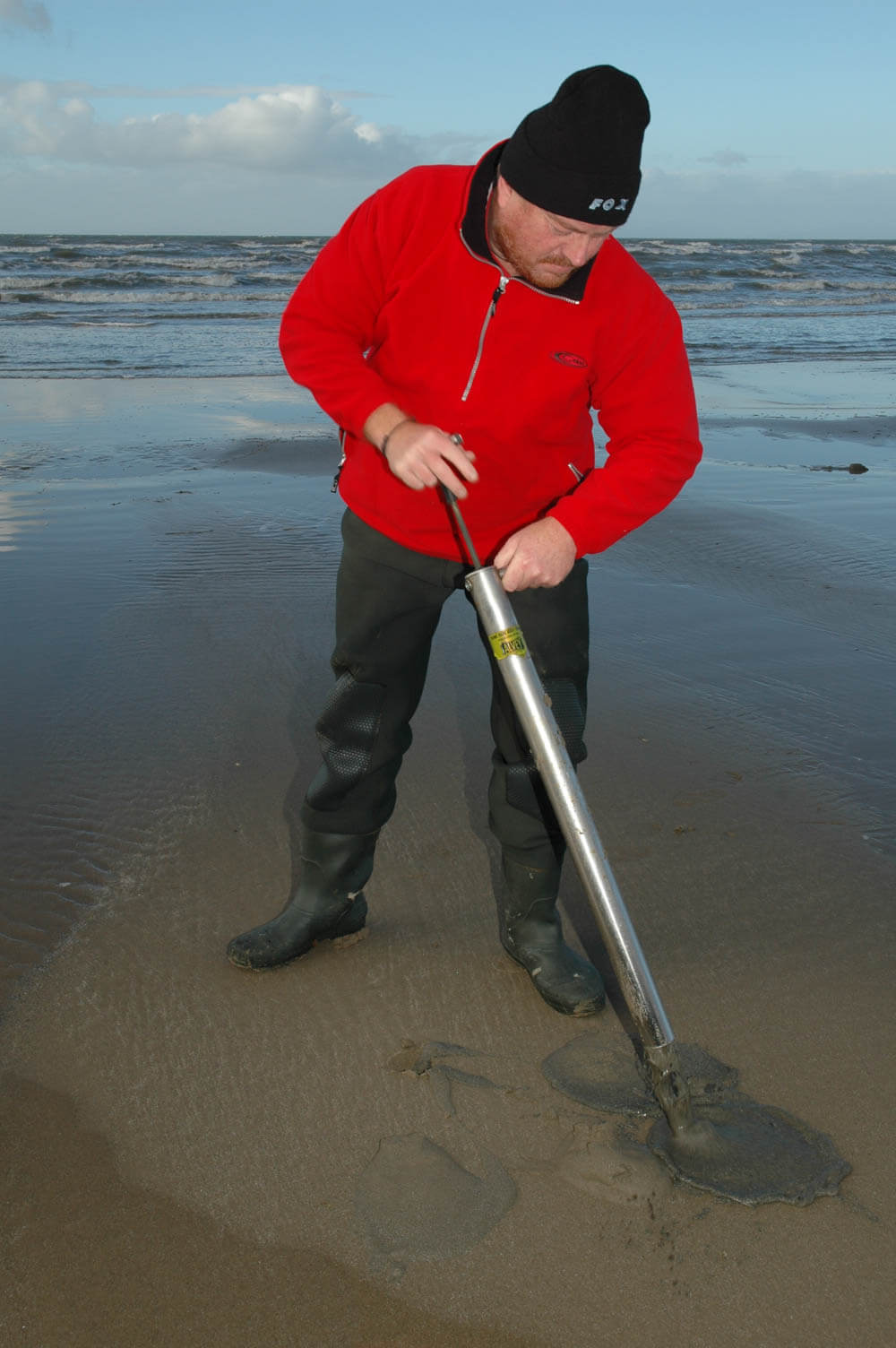The most useful tool of all for the bait digger is the humble fork.The more usual garden fork with it's narrow three or four prong construction is the one to choose for turning over mixed mud and stone when searching out individual king ragworm. The narrowness of the these forks helps them find a way down between the stones and allows the digger to work quicker by keeping excavated mud to a minimum.
The most successful technique for king rag is to look for their tell tail blow hole in the mud, which, when you stand near to it will flood with water. Start by digging the mud from around the hole, then continue working away from this in an ever widening circle until the worm is located.
Blow lugworm live in large concentrated colonies along the mid water line of lee beaches and inside estuaries. These can be trenched in numbers using a flat tined potato fork. These forks are wider than normal garden forks and have longer prongs. New forks come with wooden shafted handles. These can break very easily and experienced lug diggers replace this, either with some alloy tubing, or even straight exhaust tubing. Heavy yes, but far stronger.

Trenching is easy. Dig a straight line one fork deep and 6ft wide to start. Dug sand should be placed tidily in front of the dug trench. Simply keep working backwards one trench at a time using the dug sand to refill the previous trench as you would when digging your garden. This leaves no permanent scar showing where you dug as the next few tides come and go. The exposed worms can be easily seen as each fork of sand is turned over.
Black lugworm live right at the low water line of big spring tides. These can be collected using two types of implements.
Custom made lug spades are by far the most popular. These are usually made from a standard ladies size garden spade that, instead of being square, taper to half width at their cutting edge. This narrow pattern again keeps dug sand to a minimum aiding speed and depth.
Start by locating where the worms burrow is by finding a tell tale cast at the surface. Start digging about 6ins (15cm) in front of this going a blades depth down. Now move back to where the original cast was and take a deeper cut to about 12ins (30cm) deep. Move back again and go down a good 18ins (45cm). It's usually this third cut that locates the worm.
Many anglers now prefer the bait pump for collecting black lug. These are stainless steel and pump a core of sand out up to 20ins (50cm) long. Used at an angle at first to establish the angle of the worms hole, they then pump out the sand surrounding the burrow until the worm is located. There is a knack to using these, but in the right hands they prove very effective.

A garden rake is useful for the collection of cockles that live in numbers along the estuary sandbanks and beaches. The cockle lives only a few inches at most under the surface sand and can be raked in large numbers quickly. Cockle is a good bait for flounders and codling.
An unusual implement favoured for the raking of sandeel in the southwest of England is called the vingler. This is a thin, flat blade that ends in a wide U shape. This is drawn through the edges of sandbanks at sub surface level where the sandeels lay at low water. As the blade passes over a sandeel it is pushed in to the U bend and becomes trapped. You can feel the pressure increase on the blade as the eel is brought sideways through the sand to the surface.
Always wear strong gloves when raking sandeel because often the same ground and raking tactics can produce poisonous weevers as well.
Push nets are what they sound like. A depth of netting fixed to a frame that is pushed along the low water surf line of beaches. These stir up the sand working a few yards out and in about 2ft of water collecting everything from sandeels, shrimps, small flatfish, cockles, even peeler crabs. The best netting to use is that from an old coarse anglers keepnet. A cheap and cheerful wooden frame does the job nicely. The front leading edge of the frame needs to be rounded so that it skids over the surface sand.
Ordinary landing nets can be worked up the sides of weedy harbour walls and will locate peeler crabs hiding in the weed. A length of bent coathanger wire is worth carrying when after peeler crab living along weed covered stones. The crabs hide in deep holes and the wire can be worked behind them to drag them out. Some Channel Island anglers carry geologists picks to chip out rock living ragworm from tightly packed sand and shingle, and a builders trowel is often the best weapon for getting at mud living harbour ragworm.
The most successful technique for king rag is to look for their tell tail blow hole in the mud, which, when you stand near to it will flood with water. Start by digging the mud from around the hole, then continue working away from this in an ever widening circle until the worm is located.
Blow lugworm live in large concentrated colonies along the mid water line of lee beaches and inside estuaries. These can be trenched in numbers using a flat tined potato fork. These forks are wider than normal garden forks and have longer prongs. New forks come with wooden shafted handles. These can break very easily and experienced lug diggers replace this, either with some alloy tubing, or even straight exhaust tubing. Heavy yes, but far stronger.

Trenching is easy. Dig a straight line one fork deep and 6ft wide to start. Dug sand should be placed tidily in front of the dug trench. Simply keep working backwards one trench at a time using the dug sand to refill the previous trench as you would when digging your garden. This leaves no permanent scar showing where you dug as the next few tides come and go. The exposed worms can be easily seen as each fork of sand is turned over.
Black lugworm live right at the low water line of big spring tides. These can be collected using two types of implements.
Custom made lug spades are by far the most popular. These are usually made from a standard ladies size garden spade that, instead of being square, taper to half width at their cutting edge. This narrow pattern again keeps dug sand to a minimum aiding speed and depth.
Start by locating where the worms burrow is by finding a tell tale cast at the surface. Start digging about 6ins (15cm) in front of this going a blades depth down. Now move back to where the original cast was and take a deeper cut to about 12ins (30cm) deep. Move back again and go down a good 18ins (45cm). It's usually this third cut that locates the worm.
Many anglers now prefer the bait pump for collecting black lug. These are stainless steel and pump a core of sand out up to 20ins (50cm) long. Used at an angle at first to establish the angle of the worms hole, they then pump out the sand surrounding the burrow until the worm is located. There is a knack to using these, but in the right hands they prove very effective.

A garden rake is useful for the collection of cockles that live in numbers along the estuary sandbanks and beaches. The cockle lives only a few inches at most under the surface sand and can be raked in large numbers quickly. Cockle is a good bait for flounders and codling.
An unusual implement favoured for the raking of sandeel in the southwest of England is called the vingler. This is a thin, flat blade that ends in a wide U shape. This is drawn through the edges of sandbanks at sub surface level where the sandeels lay at low water. As the blade passes over a sandeel it is pushed in to the U bend and becomes trapped. You can feel the pressure increase on the blade as the eel is brought sideways through the sand to the surface.
Always wear strong gloves when raking sandeel because often the same ground and raking tactics can produce poisonous weevers as well.
Push nets are what they sound like. A depth of netting fixed to a frame that is pushed along the low water surf line of beaches. These stir up the sand working a few yards out and in about 2ft of water collecting everything from sandeels, shrimps, small flatfish, cockles, even peeler crabs. The best netting to use is that from an old coarse anglers keepnet. A cheap and cheerful wooden frame does the job nicely. The front leading edge of the frame needs to be rounded so that it skids over the surface sand.
Ordinary landing nets can be worked up the sides of weedy harbour walls and will locate peeler crabs hiding in the weed. A length of bent coathanger wire is worth carrying when after peeler crab living along weed covered stones. The crabs hide in deep holes and the wire can be worked behind them to drag them out. Some Channel Island anglers carry geologists picks to chip out rock living ragworm from tightly packed sand and shingle, and a builders trowel is often the best weapon for getting at mud living harbour ragworm.

